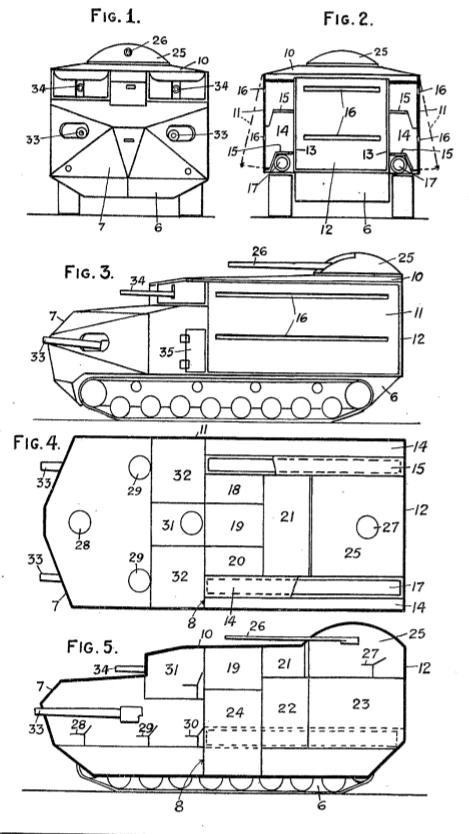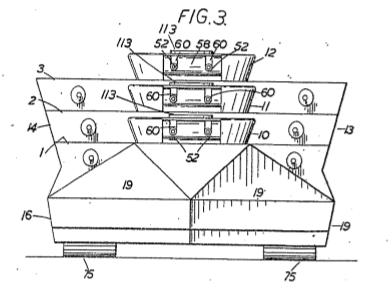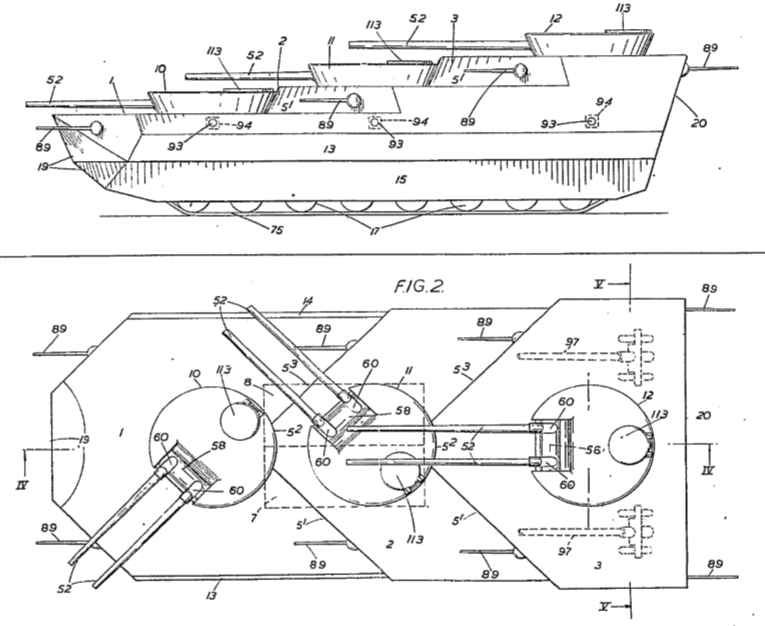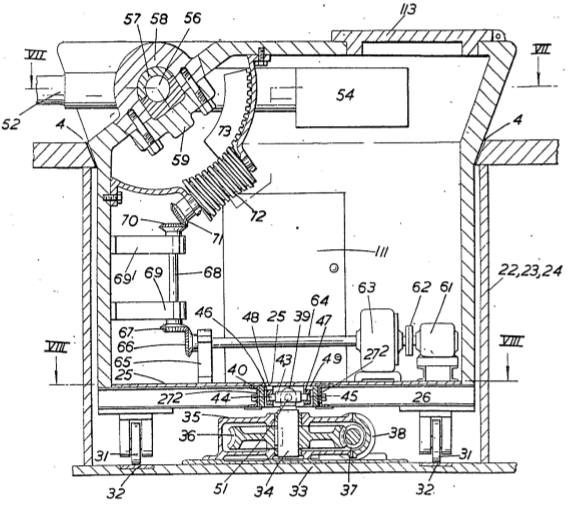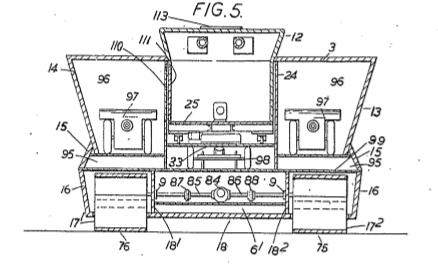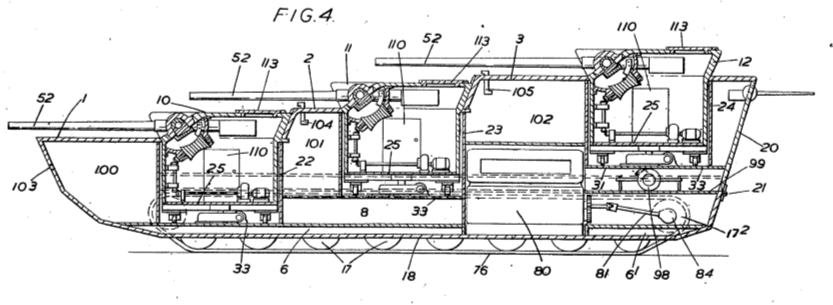Polish tank designs – Paweł Chrobok
by Bin4r · Published 17:09, 9 August 2017 · Updated 22:35, 9 August 2017
Volketten dug up sketches and patents of a Silesian insurgent: Paweł Chrobok There have already been a lot of posts about them on the web and below we present one of them. Have a nice read!
The enigmatic Colonel Chrobok
Of the many Polish tank designs from before 1945, those by Paweł Chrobok are probably the most unusual. Very little is known about Chrobok himself, apart from a few patents signed with his name during the time when he lived in exile in Great Britain during World War II. In 1940-1941, Colonel Chrobok of the Polish Armed Forces in Great Britain submitted two designs of a hybrid vehicle in Rothesay, Scotland, combining the features of an armored personnel carrier and a tank.
First project
The first design of the Chrobok was submitted in December 1940 at the Polish Armed Forces base in Rothesay under the title “Improvements Relating to Automobile Gun-Carriages”. The aim of the project was to provide heavy and light armament in a tank capable of carrying an infantry contingent and other light equipment, such as light field guns, at the same time.
The front part of the project was intended to concentrate armament of various types, consisting of heavy anti-tank guns, heavy machine guns, flamethrowers and anti-aircraft guns. The entire vehicle was to be armored, with particular emphasis on the crew compartment. The rear transport part was to have armored sides and, depending on the requirements, a covered fabric or armored roof.
Inside the transport compartment there were longitudinally arranged benches in a stepped arrangement for the transported soldiers with space for equipment under them. The entire compartment was accessible through a large rear hatch that could open both downwards and to the side. The side walls could also be opened to facilitate loading and unloading supplies or the wounded. The full patent specification was completed on 27 December 1941 and was accepted on 6 July 1942 under the patent number GB 546,287(A).
Improvements
In January 1941, the author submitted a second, revised version of his design, this time under the title “An Improved Armoured Gun Carriage”. The biggest change that the revised project brought was the addition of a small, round turret to the rear of the vehicle, which was intended to serve as a place for anti-aircraft weapons. A less obvious difference was the addition of two parallel firing holes, allowing the landing soldiers to fire from inside the vehicle.
The third great technical idea
Despite favorable opinions about his patents, Colonel Chrobok decided to leave the Polish army camp in February 1943 and move permanently to London, where he continued his work. It mainly focused on new equipment to help fight fires and a new tank design. This vehicle could be used as an offensive or defensive machine, and according to Chrobak’s notes, it was equipped with “very powerful offensive armament”. Using the similar shape and hull properties of previous designs, Chrobak enriched the new machine with cylindrical turrets (one or more pieces), which were to be “blended” into the hull, and whose dimensions were to be almost 3/4 of the overall width of the vehicle. Moreover, thanks to its special shapes, this tank could also move on the reins and act as an amphibious vehicle.
The turrets themselves were to be arranged in a “stepped” manner, so that they could fire without colliding with each other in any way. Each of the turrets was to be equipped with two cannons, which in turn could be lowered and lifted by special electric motors. The armament should also include a number of machine guns located on the extreme points of the “steps” and two light machine guns located at the rear of the tank. The exact composition of the “very powerful offensive armament” included 40-60 mm rifles with a length of 3.5 meters on the first two turrets and a 40-60 mm rifle with a length of 4.5 meters in the rear turret. There would also be side flamethrowers and a mine launcher, which the designer placed in the floor.
Almost 10 people would be used to operate this monster (two gunners and one observer on each deck). The comfort of the crew would be ensured by special fans. Convenient control of this beast would be provided by independent engines for each of the tracks, which would make it easier to maneuver the machine. The fuel tank would be placed under the engine compartment, because the author also provided more than one in his tank.
The safety of the crew and components was to be ensured by well-angled armor, the purpose of which was to withstand infantry fire and larger tank guns. There was enough space on the deck to carry a 75mm all-terrain gun.
Chrobak constantly improved his design until December 1943, and then abruptly abandoned his work on the machine. These designs were discovered only later in the archives of the patent office where Chrobak filed his papers. Although these tanks could not have been built at that time, Chrobak’s notes certainly have a very high historical value. Still little is known about the author of the designs. On the Internet you can find several encyclopedic pages about the person of Colonel Chrobak, but none of them is fully reliable.
Summary
Colonel Chrobok projects were interesting and combined many different ideas, but they were simply not feasible. They were too big, had too many guns and turrets, and were a nightmare for the commander who was supposed to be in charge of it all. These were very complicated ideas created at a time when Poland was in German hands and British industry was trying to promote its own projects. These projects were also very expensive to produce (both the cost of creating the tank itself and the need to hire people to do it). Whoever Paweł Chrobok was, he went down in military history as the originator of wonderful, but at the same time very strange ideas. Still, its tanks could fill the so-called “black hole” in the history of Polish tank technology, even if now, after 70 years, its solutions seem obsolete and unfeasible.
challenge restriction it cant be a ‘land ship’ lit the german rats

